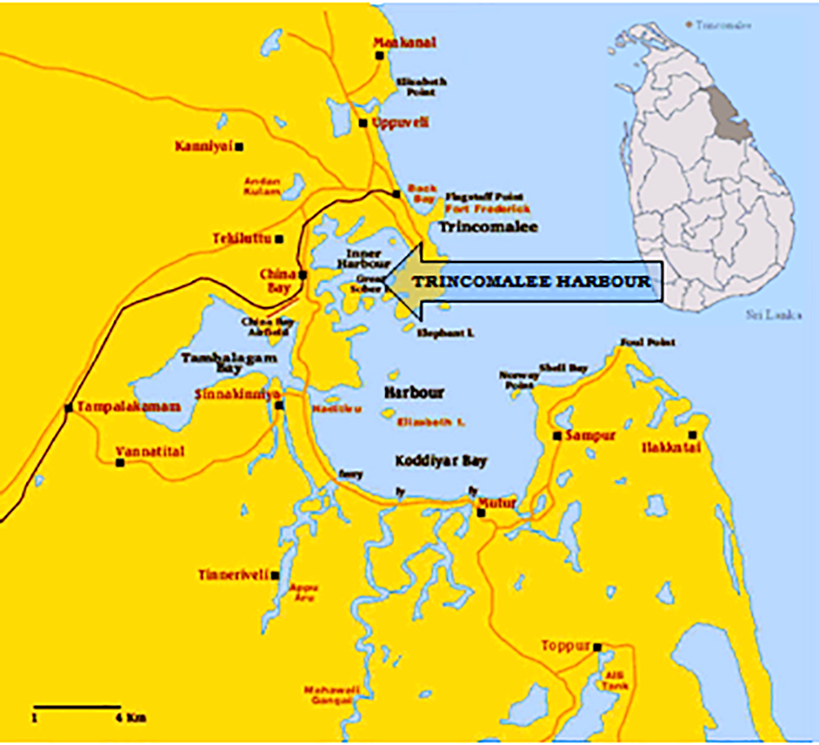Trincomalee Oil Tank Farm Deal: India- Srilanka | 28 Dec 2021
For Prelims: Trincomalee oil tank farms deal, location of Trincomalee port, Katchatheevu Island Issue, Four-Pillar Initiative, India and Sri Lanka conducted joint Military exercises, Foreign Direct Investment (FDI), Lines of Credit, currency swap agreement.
For Mains: India-Sri Lanka Relations, Indo-Lanka Accord 1987, Issues in India-Sri Lanka Relations
Why in News
In the coming days, India and Sri Lanka are going to sign the long pending deal to jointly develop the Trincomalee oil tank farms.
- The signing of the deal will reflect a positive sign, amidst strained relationship between the two countries.
Key Points
- About Trincomalee Oil Tank Farms:
- The oil tank farm was built by the British during World War II as a refuelling station,
- It is located in ‘China Bay’ in close proximity to the internationally coveted deep water natural harbour of Trincomalee.
- The proposal of this joint development was envisaged 35 years ago, in the Indo-Lanka Accord 1987.
- It comprises 99 storage tanks, with a capacity of 12,000 kilolitres each, spread across Lower Tank farm and Upper Tank Farm.
- In 2003, Indian Oil Corporation set up its Sri Lankan subsidiary called Lanka IOC, to work on this oil farm.
- Currently, Lanka IOC runs 15 tanks. The new agreement is being negotiated for the remaining tanks.
- Significance of the deal:
- The Trincomalee Oil Tank Farms have been bestowed with several favourable factors of location. For example,
- Easily Accessible: It is located on a deep water natural harbour of Trincomalee.
- Strategic Location in the Indian Ocean: These oil farms are located along some of the world’s busiest shipping lanes.
- Thus, a well-developed oil storage facility and refinery adjacent to the Trincomalee Port would have great economic value for both India and Sri Lanka.
- The Trincomalee Oil Tank Farms have been bestowed with several favourable factors of location. For example,
Indo-Lanka Accord
- It is popularly referred to as the Rajiv-Jayewardene Accord, after its architects Prime Minister of India Rajiv Gandhi and Sri Lankan President J.R. Jayewardene. It was signed in 1987.
- It was signed on the pretext of the Civil War in Sri Lanka (between Tamils and Sinhala community).
- The accord sought to balance India’s strategic interests, interest of people of Indian origin in Sri Lanka and Tamil minority rights in Sri Lanka.
- The accord saw the placement of the Indian Peace Keeping Force (IPKF) in Sri Lanka to resolve the Sri Lankan Civil War.
- The accord also resulted in enactment of the thirteenth Amendment to the Constitution of Sri Lanka and the Provincial Councils Act of 1987.
- Issues in India-Sri Lanka Relations
- China’s Intervention: China’s rapidly growing economic footprint (and political clout as a corollary) in Sri Lanka is straining India-Sri Lanka relations.
- China is already the largest investor in Sri Lanka, accounting for 23.6% of the total Foreign Direct Investment (FDI) during 2010-2019 as against 10.4% from India.
- China is also one of the largest export destinations for Sri Lankan goods and holds over 10% of its external debt.
- China is also handling Hambantota Port of Sri Lanka, the port is viewed as a part of China’s String of Pearls Strategy.
- Katchatheevu Island Issue: India ceded the uninhabited island to its southern neighbour in 1974 under a conditional accord.
- However, many times the fisherman issue arises more out of a domestic tussle rather than the India-Sri Lanka view on the issue.
- 13th Amendment of the Sri Lankan Constitution: Indo-Sri Lankan Accord was signed in 1987 to provide a political solution to Sri Lanka’s conflict.
- It envisages devolution of necessary powers to the provincial councils to address the just demand of the Tamil people for equality, justice, peace, and respect within a united Sri Lanka.
- The provisions of this accord were made in the Sri Lankan constitution, by the Thirteenth Amendment.
- However, still the provisions are not implemented on ground. Even to this day, s lot of Srilankan Tamils who evaded from Srilankan civil war (2009) are seeking refuge in Tamil Nadu.
- Back Tracing of Sri-Lanka: Recently, Sri Lanka backed out from a tripartite partnership with India and Japan for its East Container Terminal Project at the Colombo Port, citing domestic issues.
- China’s Intervention: China’s rapidly growing economic footprint (and political clout as a corollary) in Sri Lanka is straining India-Sri Lanka relations.
India-Sri Lanka Cooperation: Recent Developments
- Four-Pillar Initiative: Recently, India and Sri Lanka agreed to a four-pronged approach to discuss initiatives on food and energy security to help mitigate Sri Lanka’s economic crisis.
- This Four-Pillar Initiative comprises Lines of Credit, currency swap agreement, Modernisation Project (like The Indian Housing Project) and Indian Investments.
- Joint Exercises: India and Sri Lanka conducted joint Military (Mitra Shakti) and Naval exercise (SLINEX).
- Participation in Groupings: Sri Lanka is also a member of regional groupings like BIMSTEC (Bay of Bengal Initiative for Multi-Sectoral Technical and Economic Cooperation) and SAARC in which India plays a leading role.
- SAGAR Vision: Srilanka supports India’s concern for the security of the Indian ocean with its ‘Neighbourhood First’ policy and SAGAR (Security and Growth for all in the Region).
Way Forward
- Nurturing the Neighbourhood First policy with Sri Lanka is important for India to preserve its strategic interests in the Indian Ocean region.
- Indian foreign policy towards Sri Lanka, as part of its ‘Island Diplomacy’, will also have to evolve in tune to the emergent realities and threats.
- Both countries can also cooperate on enhancing private sector investments to create economic resilience.

